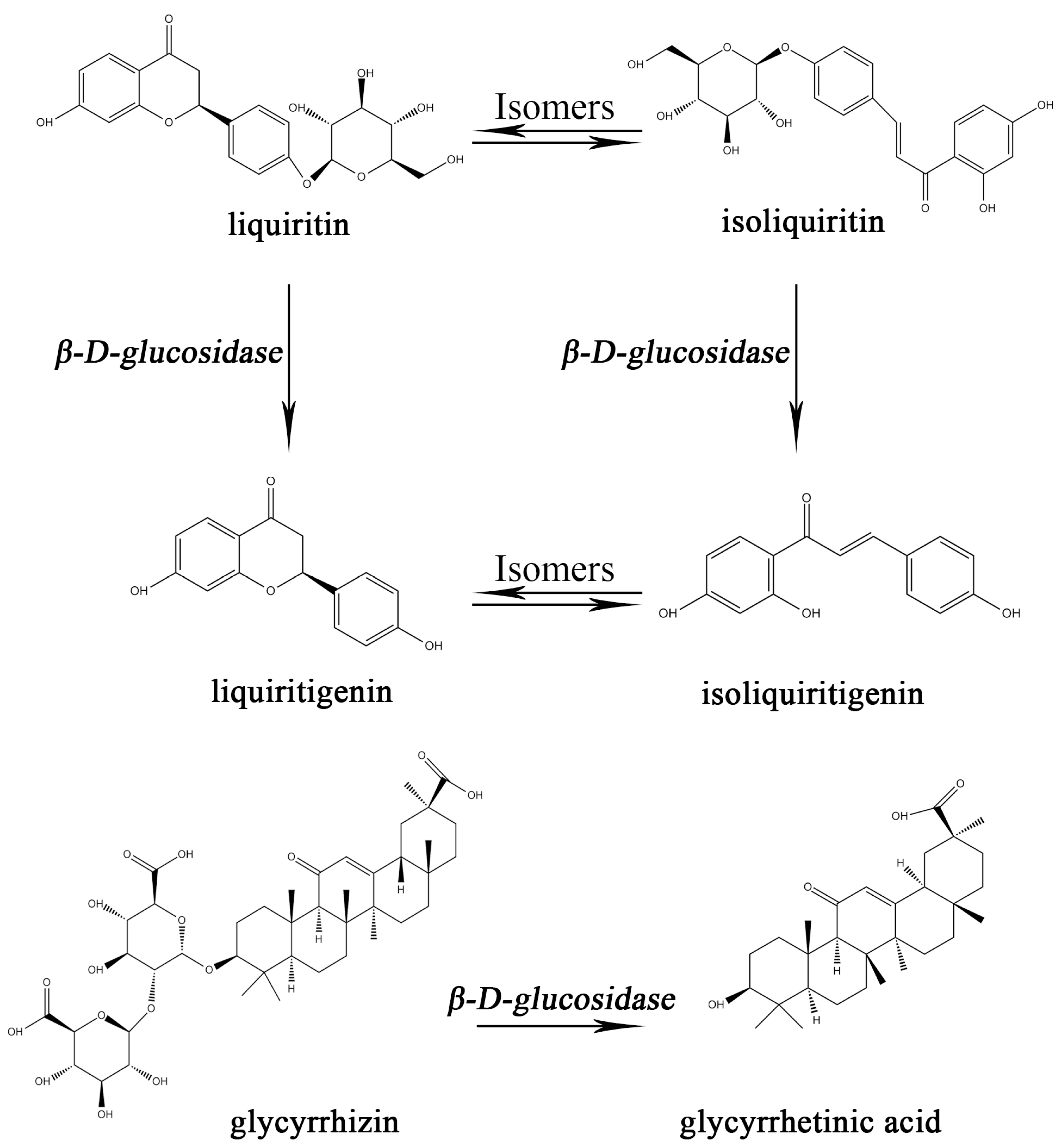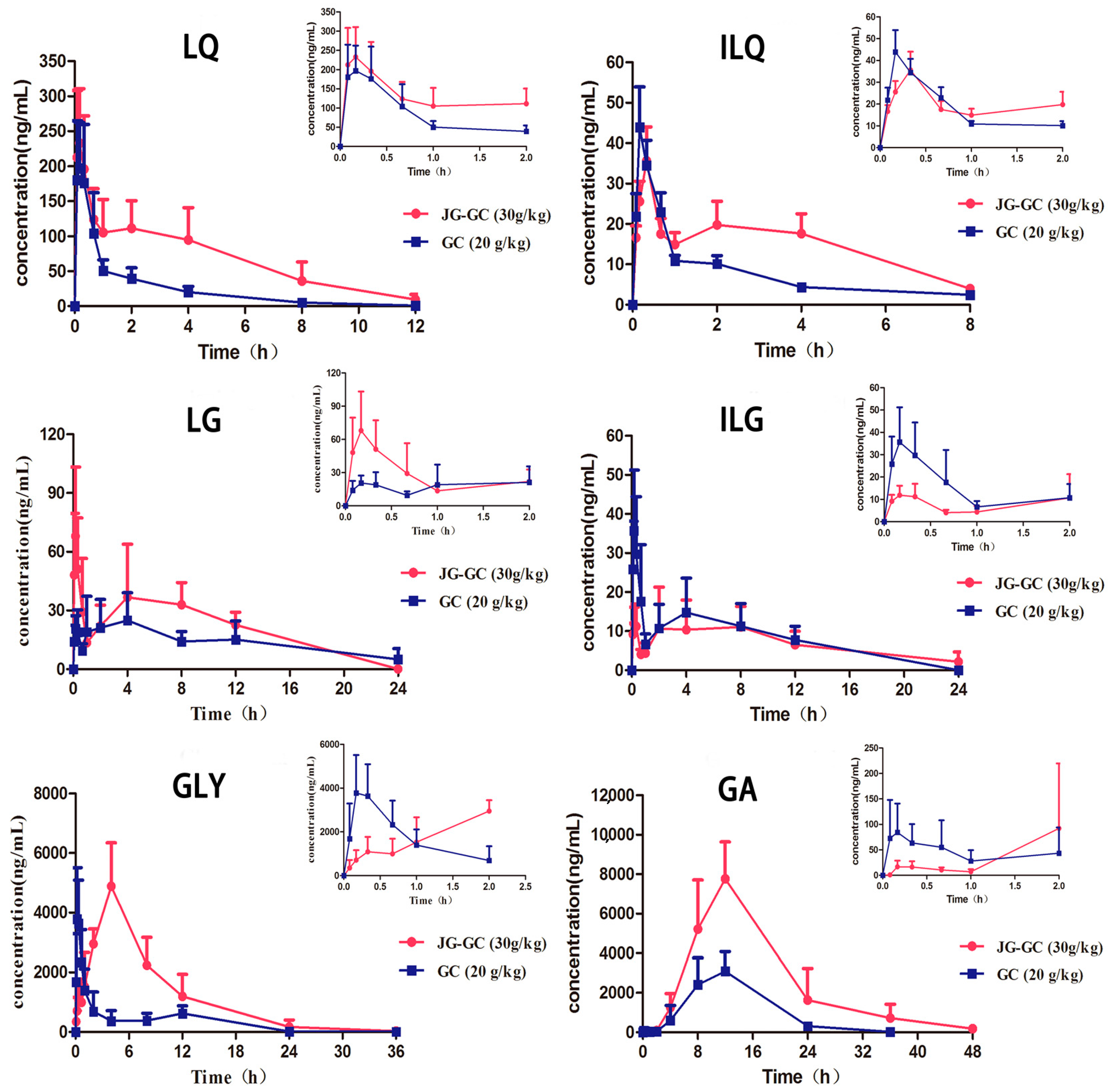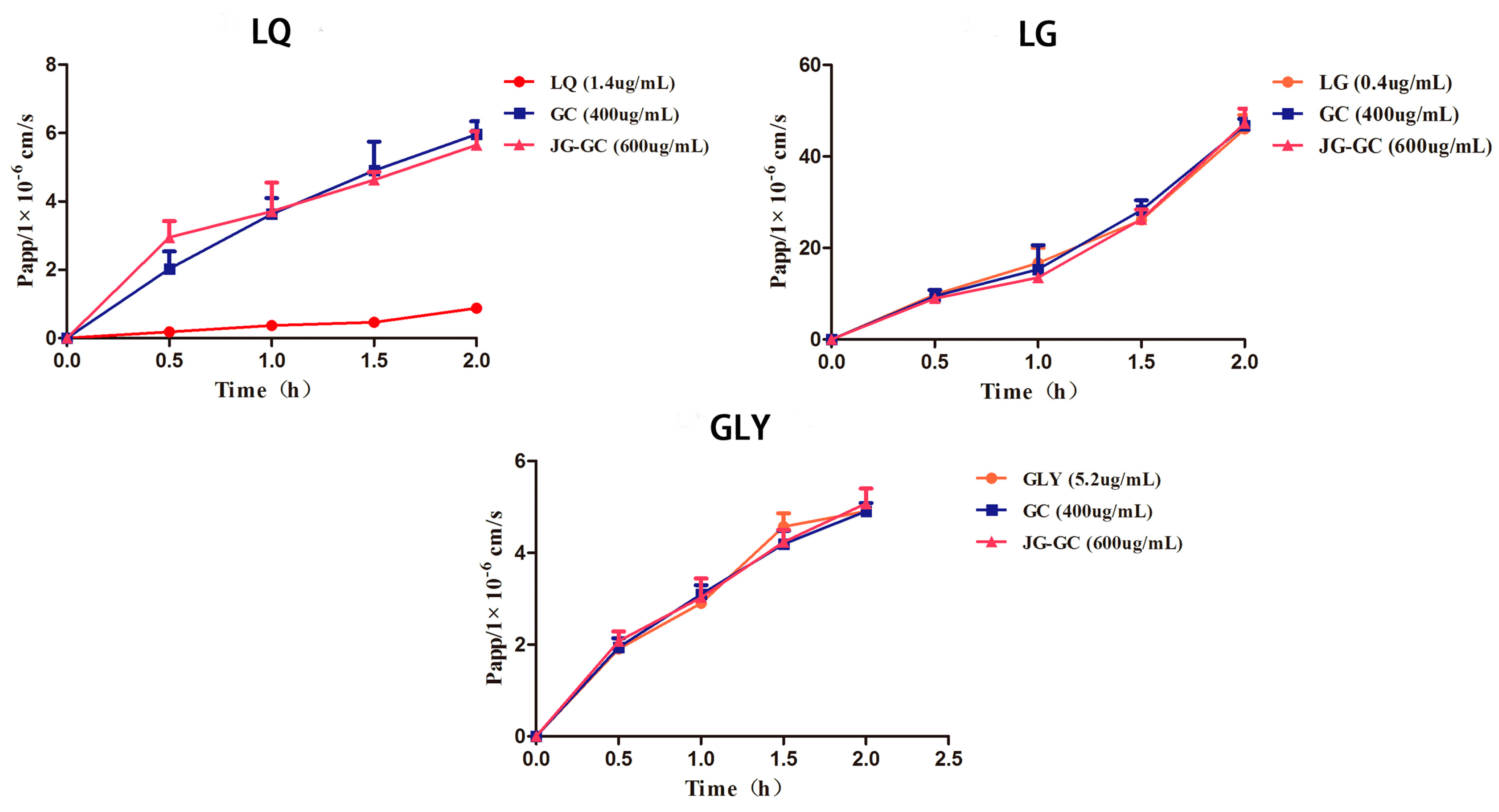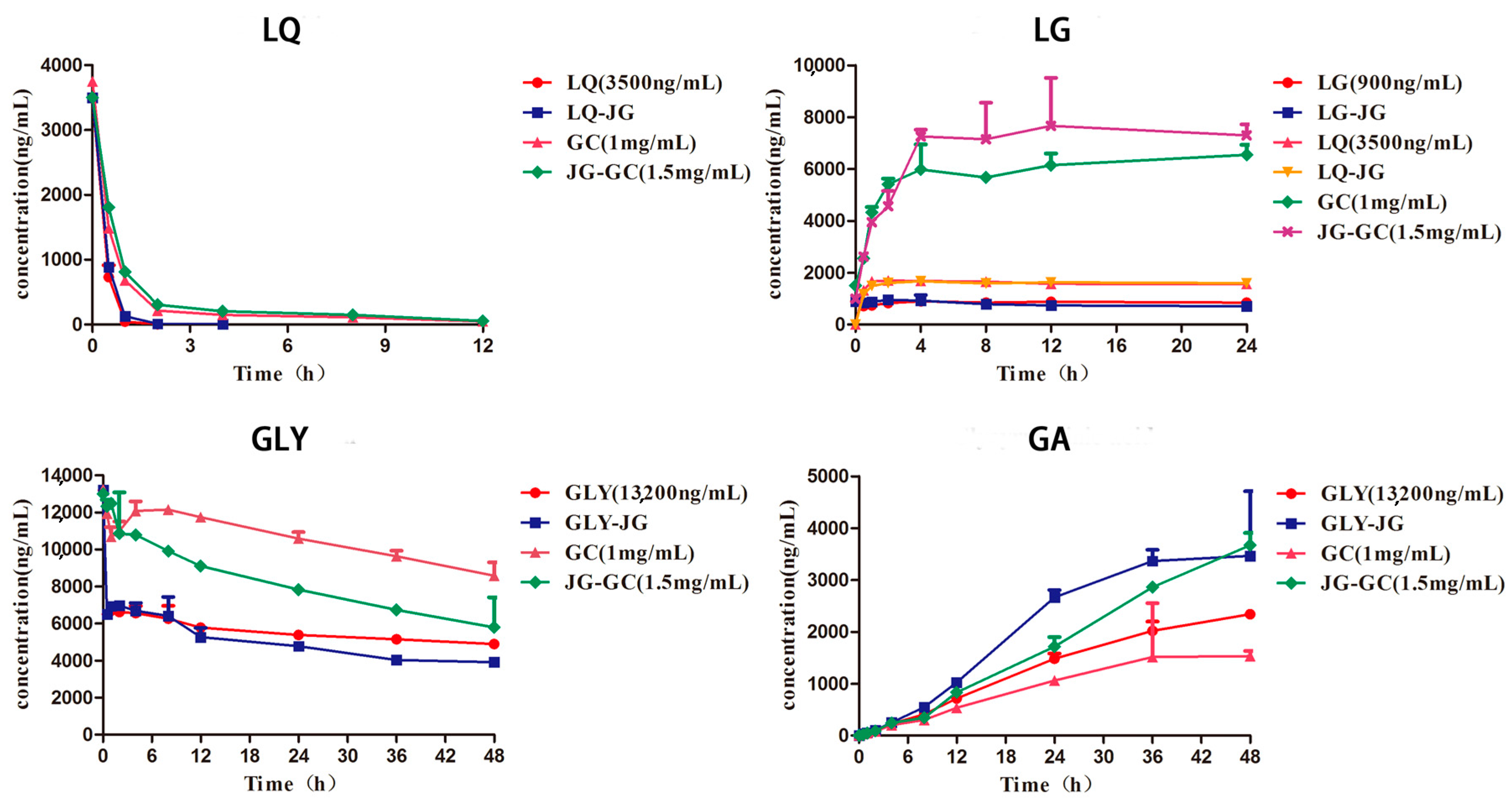Influence of Jiegeng on Pharmacokinetic Properties of Flavonoids and Saponins in Gancao
Abstract
:1. Introduction
2. Results and Discussion
2.1. Oral Pharmacokinetics Study
2.2. Transcellular Transport of LQ, LG and GLY across Caco-2 Cell Monolayer
2.3. Hydrolysis of LQ, LG and GLY in Fecal Lysates
3. Materials and Methods
3.1. Reagents and Materials
3.2. Preparation of Sample Extracts
3.3. Animals
3.4. Pharmacokinetic Study
3.5. Cell Culture
3.6. Transport of LQ, LG and GLY across Caco-2 Cell Monolayer
3.7. Fecal Lysates Preparation
3.8. Metabolism of LQ, LG and GLY in Fecal Lysates
3.9. Quantification of Flavonoids and Saponins in Biological Matrices
4. Conclusions
Acknowledgments
Author Contributions
Conflicts of Interest
References
- Kao, T.C.; Wu, C.H.; Yen, G.C. Bioactivity and potential health benefits of licorice. J. Agric. Food Chem. 2014, 62, 542–553. [Google Scholar] [CrossRef] [PubMed]
- Liu, H.M.; Sugimoto, N.; Akiyama, T.; Maitani, T. Constituents and their sweetness of food additive enzymatically modified licorice extract. J. Agric. Food Chem. 2000, 48, 6044–6047. [Google Scholar] [CrossRef] [PubMed]
- Alrushaid, S.; Davies, N.M.; Martinez, S.E.; Sayre, C.L. Pharmacological characterization of liquiritigenin, a chiral flavonoid in licorice. Res. Pharm. Sci. 2016, 11, 355–365. [Google Scholar] [PubMed]
- Ren, L. Study on pharmacological activity of effective components of glycyrrhiza uralensis fisch. Biotechworld 2016, 5, 227. [Google Scholar]
- Yang, R.; Wang, L.Q.; Yuan, B.C.; Liu, Y. The pharmacological activities of licorice. Planta Med. 2015, 81, 1654–1669. [Google Scholar] [CrossRef] [PubMed]
- Zhang, M.F.; Shen, Y.Q. Research advances in pharmacologic effects of licorice and its active components in hypoglycemia. Anti-Infect. Pharm. 2015, 1, 1–5. [Google Scholar]
- Wang, L.; He, Y.; Zhang, Y.; Zhou, H.; Yu, L.; Yang, J.; Wan, H. Effects of active components of fuzi and gancao compatibility on bax, bcl-2, and caspase-3 in chronic heart failure rats. Evid. Based Complement. Alternat. Med. 2016, 2016, 7686045. [Google Scholar] [CrossRef] [PubMed]
- Wang, Q.; Shi, L.; Tang, X.; Wang, Q.; Dang, X.; Zhang, Y. Pharmacokinetic study of multiple active constituents from kushen-gancao decoction after oral administration in rat by hplc-ms/ms. J. Chromatogr. B 2014, 965, 19–26. [Google Scholar] [CrossRef] [PubMed]
- Zhou, B.; Zhang, J.; Wu, S.; Zhuo, Q.; Gao, W.; Hao, J.; Man, S. The influence of compatibility of processed radix aconiti kusnezoffii on the pharmacokinetic of four components in glycyrrhiza uralensis fisch. J. Ethnopharmacol. 2015, 169, 1–7. [Google Scholar] [CrossRef] [PubMed]
- Carbonell-Barrachina, A.A.; Aracil, P.; Garcia, E.; Burlo, F.; Martinez-Sanchez, F. Source of arsenic in licorice confectionery products. J. Agric. Food Chem. 2003, 51, 1749–1752. [Google Scholar] [CrossRef] [PubMed]
- Zhang, Q.; Ye, M. Chemical analysis of the chinese herbal medicine gan-cao (licorice). J. Chromatogr. A 2009, 1216, 1954–1969. [Google Scholar] [CrossRef] [PubMed]
- Ohno, H.; Araho, D.; Uesawa, Y.; Kagaya, H.; Ishihara, M.; Sakagami, H.; Yamamoto, M. Evaluation of cytotoxiciy and tumor-specificity of licorice flavonoids based on chemical structure. Anticancer Res. 2013, 33, 3061–3068. [Google Scholar] [PubMed]
- Zhang, J.; Gao, W.; Yan, S.; Zhao, Y. Effects of space flight on the chemical constituents and anti-inflammatory activity of licorice (glycyrrhiza uralensis fisch). Iran. J. Pharm. Res. 2012, 11, 601–609. [Google Scholar] [PubMed]
- Li, W.; Liu, Y.; Wang, Z.; Han, Y.; Tian, Y.H.; Zhang, G.S.; Sun, Y.S.; Wang, Y.P. Platycodin d isolated from the aerial parts of platycodon grandiflorum protects alcohol-induced liver injury in mice. Food Funct. 2015, 6, 1418–1427. [Google Scholar] [CrossRef] [PubMed]
- Li, Y.; Wang, J.T.; Gui, S.Y.; Qu, H.F. Progress on chemical constituents and pharmacological effects of platycodon grondiflonm. Food Drug 2016, 18, 72–75. [Google Scholar]
- Zhang, L.; Wang, Y.; Yang, D.; Zhang, C.; Zhang, N.; Li, M.; Liu, Y. Platycodon grandiflorus—An ethnopharmacological, phytochemical and pharmacological review. J. Ethnopharmacol. 2015, 164, 147–161. [Google Scholar] [CrossRef] [PubMed]
- Fu, W.W.; Dou, D.Q.; Pei, Y.H. Review on chemical components and bioactivities of platycodon grandiflorum. J. Shenyang Pharm. Univ. 2006, 23, 184–191. [Google Scholar]
- Guo, W.J.; Xu, X.D.; Wei, J.H.; Yang, J.S. Advances in studies on chemical constituents of triterpenoid saponins from platycodon grandiflorum. Chin. Pharm. J. 2008, 43, 801–804. [Google Scholar]
- Zhao, X.Y.; Zhu, G.W. Study on the correlation between compatibility and pharmacodynamics of campanulaceae and glycyrrhiza uralensis. China’s Naturop. 2014, 22, 58–59. [Google Scholar]
- Shan, J.J.; Zou, J.S.; Xu, J.Y.; Yu, J.H.; Di, L.Q.; Wang, S.C. Research advances of jiegeng tang. Chin. J. Exp. Tradit. Med. Formulae 2012, 18, 304–306. [Google Scholar]
- Liu, B.; Qi, Y.; Song, Y.; Cai, R.L.; Wang, M.; Xie, C.; Luo, X.Z. Combination of saponins of glycyrrhiza uralensis fisch( gs)and platycodon grandiflorum A. Dc(ps)for duration of effect. Chin. J. Exp. Tradit. Med. Formulae 2007, 13, 28–31. [Google Scholar]
- Cheng, J.; Di, L.Q.; Shan, J.J.; Zhao, X.L.; Kang, A.; Bi, X.L.; Li, J.S. Studies on effects of achyranthes bidentata on tongsaimai pellets main active ingredients chlorogenic acid, isoliquiritin, harpagoside and glycyrrhizin in vivo pharmacokinetics. China J. Chin. Mater. Med. 2014, 39, 1502–1508. [Google Scholar]
- Wu, Y.P.; Meng, X.S.; Bao, Y.R.; Wang, S. Pharmacokinetic study of four flavones of glycyrrhiza in rat plasma using hplc-ms. J. Ethnopharmacol. 2013, 148, 266–270. [Google Scholar] [CrossRef] [PubMed]
- Shan, J.J.; Zou, J.S.; Xie, T.; Kang, A.; Zhou, W.; Xu, J.Y.; Shen, C.S.; Du, L.N.; Wang, S.C.; Di, L.Q. Effects of gancao on pharmacokinetic profiles of platycodin D and deapio-platycodin D in jiegeng. J. Ethnopharmacol. 2015, 170, 50–56. [Google Scholar] [CrossRef] [PubMed]
- Zhang, W.; Jiang, S.; Qian, D.; Shang, E.X.; Duan, J.A. Effect of liquiritin on human intestinal bacteria growth: Metabolism and modulation. Biomed. Chromatogr. 2014, 28, 1271–1277. [Google Scholar] [CrossRef] [PubMed]
- Li, Y.Y.; Jiang, Z.Z.; Zhang, L.; Chai, X.; Wang, Y.F. Characterization of metabolites of liquirtigenin in rats by uplc-q-tof/ms. Tianjin J. Tradit. Chin. Med. 2015, 32, 757–762. [Google Scholar]
- Akao, T. Effects of glycyrrhizin and glycyrrhetic acid on the growth, glycyrrhizin beta-d-glucuronidase and 3 beta-hydroxysteroid dehydrogenase of human intestinal bacteria. Biol. Pharm. Bull. 2000, 23, 104–107. [Google Scholar] [CrossRef] [PubMed]
- Dong, S.Q.; Fan, H.R.; Li, Q.S.; Wei, G.L.; Liu, W.H.; Si, D.Y. In vivo metabolic pathway of liquiritin in rats. Chin. Tradit. Herb. Drugs 2014, 45, 2499–2505. [Google Scholar]
Sample Availability: Samples of the compounds are available from the authors. |

 ): JG–GC (30 g/kg, p.o.); Group 2 (
): JG–GC (30 g/kg, p.o.); Group 2 (  ): GC (20 g/kg, p.o.). The upper right corner of each drug curve shows the corresponding drug profile within 2 h.
): GC (20 g/kg, p.o.). The upper right corner of each drug curve shows the corresponding drug profile within 2 h.
 ): JG–GC (30 g/kg, p.o.); Group 2 (
): JG–GC (30 g/kg, p.o.); Group 2 (  ): GC (20 g/kg, p.o.). The upper right corner of each drug curve shows the corresponding drug profile within 2 h.
): GC (20 g/kg, p.o.). The upper right corner of each drug curve shows the corresponding drug profile within 2 h.


| Parameter | LQ | ILQ | LG | |||
| GC | JG–GC | GC | JG–GC | GC | JG–GC | |
| Cmax (ng/mL) | 2.48 ± 72.6 | 294 ± 52.4 | 45.9 ± 14.5 | 35.6 ± 7.08 | 47.9 ± 9.24 | 37 ± 9.79 |
| t1/2 (h) | 2.02 ± 0.90 | 2.54 ± 0.81 | 4.78 ± 0.84 | 2.93 ± 0.89 | 2.80 ± 0.19 | 2.54 ± 0.81 |
| Tmax (h) | 0.14 ± 0.043 | 0.13 ± 0.046 | 0.25 ± 0.09 | 0.33 ± 0 | 0.78 ± 0.05 | 1.29 ± 0.05 |
| AUC(0–t) (ng/mL·h) | 301.9 ± 58.1 | 1104.5 ± 270 * | 75.3 ± 17.6 | 136 ± 36.5 | 533.3 ± 191.8 | 304.4 ± 59.1 ** |
| AUC(0–∞) (ng/mL·h) | 303 ± 58.4 | 1106 ± 269 * | 76.6 ± 17.2 | 137 ± 36.5 | 545 ± 213 | 262 ± 55.6 ** |
| Parameter | ILG | GLY | GA | |||
| GC | JG–GC | GC | JG–GC | GC | JG–GC | |
| Cmax (ng/mL) | 45.2 ± 13.3 | 17.3 ± 5.09 * | 4102 ± 1307 | 5190 ± 1228 | 3109 ± 1007 | 7848 ± 1862 * |
| t1/2 (h) | 3.37 ± 0.33 | 4.41 ± 1.04 | 3.03 ± 0.48 | 3.43 ± 0.87 | 4.22 ± 0.87 | 6.00 ± 1.78 |
| Tmax (h) | 1.56 ± 0.25 | 1.78 ± 0.096 | 0.39 ± 0.11 | 4.83 ± 0.89 * | 11.3 ± 1.63 | 11.3 ± 1.63 |
| AUC(0–t) (ng/mL·h) | 201.8 ± 54.4 | 120.4 ± 31.5 * | 13,530.7 ± 4038 | 41,241.1 ± 10,290 * | 40,353.5 ± 9018.2 | 117,529.5 ± 20,640.3 * |
| AUC(0–∞) (ng/mL·h) | 205 ± 52.9 | 129 ± 21.5 | 13,532 ± 4037 | 41,248 ± 10,284 * | 40,418 ± 8993 | 118,998 ± 21,515 * |
| Time (min) | Papp-LQ (1 × 10−6 cm/s) | Papp-LG (1 × 10−6 cm/s) | Papp-GLY (1 × 10−6 cm/s) | ||||||
|---|---|---|---|---|---|---|---|---|---|
| LQ | GC | JG–GC | LG | GC | JG–GC | GLY | GC | JG–GC | |
| 30 | 0.18 ± 0.01 | 2.03 ± 0.51 ** | 2.95 ± 0.47 ## | 9.80 ± 0.78 | 9.48 ± 1.35 | 8.98 ± 0.70 | 1.91 ± 0.23 | 1.94 ± 0.20 | 2.08 ± 0.21 |
| 60 | 0.37 ± 0.07 | 3.63 ± 0.47 ** | 3.71 ± 0.84 ## | 16.70 ± 3.30 | 15.30 ± 5.32 | 13.50 ± 0.19 | 2.90 ± 0.07 | 3.10 ± 0.20 | 3.03 ± 0.41 |
| 90 | 0.46 ± 0.13 | 4.90 ± 0.85 ** | 4.63 ± 0.23 ## | 26.10 ± 0.23 | 28.30 ± 2.12 | 26.30 ± 2.15 | 4.57 ± 0.29 | 4.19 ± 0.29 | 4.24 ± 0.26 |
| 120 | 0.88 ± 0.10 | 5.96 ± 0.38 ** | 5.65 ± 0.40 ## | 46.00 ± 3.07 | 46.70 ± 1.50 | 47.30 ± 3.15 | 4.91 ± 0.05 | 4.91 ± 0.18 | 5.08 ± 0.32 |
| Analyte | LQ | ILQ | LG | ILG | GLY |
|---|---|---|---|---|---|
| (μg/mL) | (μg/mL) | (μg/mL) | (μg/mL) | (μg/mL) | |
| JG–GC(3 g/mL) | 7100 | 600 | 2000 | 70 | 26,000 |
| GC(2 g/mL) | 7500 | 560 | 2200 | 70 | 26,500 |
| Group | LQ (ng/mL) | LG (ng/mL) | GLY (ng/mL) |
|---|---|---|---|
| JG–GC (1.5 mg/mL) | 3550 | 1000 | 13,000 |
| GC (1 mg/mL) | 3750 | 1500 | 13,250 |
| LQ | 3500 | / | / |
| LG | / | 900 | / |
| GLY | / | / | 13,200 |
| LQ+JG | 3500 | / | / |
| LG+JG | / | 900 | / |
| GLY+JG | / | / | 13,200 |
| Analyte | Rat Plasma | HBSS Buffer | Fecal Lysates | |||
|---|---|---|---|---|---|---|
| Linear Range | LLOQ | Linear Range | LLOQ | Linear Range | LLOQ | |
| (ng/mL) | (ng/mL) | (ng/mL) | (ng/mL) | (ng/mL) | (ng/mL) | |
| LG | 0.43–330 | 0.43 | 0.54–1100 | 0.54 | 2.15–2200 | 2.15 |
| ILG | 0.41–315 | 0.41 | ||||
| LQ | 0.47–360 | 0.47 | 1.47–3000 | 1.47 | 1.47–1500 | 1.47 |
| ILQ | 0.40–306 | 0.4 | ||||
| GLY | 10.26–7875 | 10.26 | 3.96–8100 | 3.96 | 5.27–5400 | 5.27 |
| GA | 14.64–11,250 | 14.64 | 2.93–3000 | 2.93 | ||
© 2017 by the authors. Licensee MDPI, Basel, Switzerland. This article is an open access article distributed under the terms and conditions of the Creative Commons Attribution (CC BY) license (http://creativecommons.org/licenses/by/4.0/).
Share and Cite
Mao, Y.; Peng, L.; Kang, A.; Xie, T.; Xu, J.; Shen, C.; Ji, J.; Di, L.; Wu, H.; Shan, J. Influence of Jiegeng on Pharmacokinetic Properties of Flavonoids and Saponins in Gancao. Molecules 2017, 22, 1587. https://doi.org/10.3390/molecules22101587
Mao Y, Peng L, Kang A, Xie T, Xu J, Shen C, Ji J, Di L, Wu H, Shan J. Influence of Jiegeng on Pharmacokinetic Properties of Flavonoids and Saponins in Gancao. Molecules. 2017; 22(10):1587. https://doi.org/10.3390/molecules22101587
Chicago/Turabian StyleMao, Yancao, Linxiu Peng, An Kang, Tong Xie, Jianya Xu, Cunsi Shen, Jianjian Ji, Liuqing Di, Hao Wu, and Jinjun Shan. 2017. "Influence of Jiegeng on Pharmacokinetic Properties of Flavonoids and Saponins in Gancao" Molecules 22, no. 10: 1587. https://doi.org/10.3390/molecules22101587




